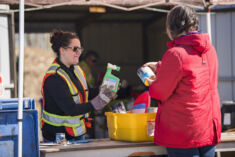Spring Cleaning and Safe Drinking Water
As sunny days and warmer temperatures are on the rise, it’s spring cleaning time! While it is great to get your house clean, the Upper Thames River Conservation Authority (UTRCA) wants to remind everyone to keep the drinking water in the UTRCA’s Source Protection Area clean too. Make sure to choose non-toxic chemicals and dispose of hazardous chemicals at your municipality’s hazardous waste disposal depot.
Take extra precaution that any hazardous chemicals do not end up going down the drain. Some household products must be stored and handled very carefully, as they may contain chemicals that could significantly threaten drinking water sources.
Chemicals called Dense Non-Aqueous Phase Liquids (DNAPLs) are nasty pollutants that are harder to clean up than other types of chemical spills. Many common household products can contain chemicals that are in this category, including adhesives, cleaners, nail polish remover, wood preservatives, metal cleaners, electronic cleaners, automobile repair, degreasers, paint removers, furniture strippers, spot removers, dry cleaning chemicals, and rug cleaning fluids.
DNAPL chemicals are heavier than water and do not dissolve easily. If they are spilled, they tend to sink down into the ground and can contaminate the soil and groundwater that we depend on for our drinking water. DNAPLs such as PCBs and mercury can stay in the environment for decades, while others can become more toxic as they break down. Even small amounts of DNAPLs can be very toxic to humans and the environment, which means that even a little getting into water makes it harmful to consume.
What can you do?
Use household chemicals properly by reading the label, follow the instructions on safe use and storage, and use sealable containers to capture spills and leaks to reduce the chance the chemical will be washed on the ground and into storm drains. Store your chemicals safely at room temperature, off the ground, in tightly sealed containers, and away from floor drains. Ensure you are disposing of leftover household chemicals safely by using your municipality’s hazardous waste drop off locations and not pouring them down drains or on the ground!
During your spring cleaning, use non-toxic chemicals and, if you’re planning on throwing out any chemicals, drop them off at your municipality’s hazardous waste drop off locations. Let’s work together to make sure we keep our drinking water sources clean!


